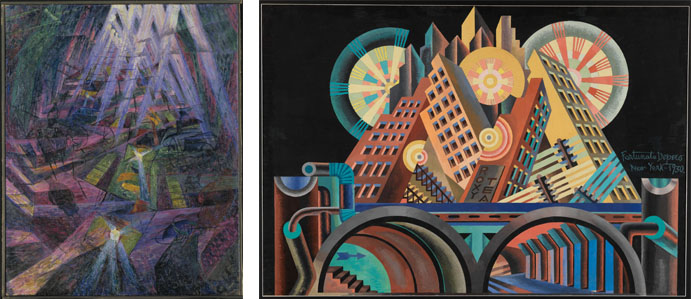The futurist ‘reconstruction of the universe’
In 1915, the futurist aesthetic ideals are laid out by Giacomo Balla and Fortunato Depero in the manifesto Ricostruzione Futurista dell’Universo. According to this manifesto, the innovations developed in the traditional arts – painting and sculpture – should be used to transform everyday life into a futurist universe: an ‘opera d'arte totale’, a total work of art, in which modern humans will live.
A first introduction
Europe is introduced to the work of the futurists in 1912 through a touring exhibition of paintings by Umberto Boccioni, Carlo Carrà, Luigi Russolo and Gino Severini, which, after Galerie Bernheim-Jeune in Paris, travels to London, Brussels, Berlin, The Hague and Amsterdam, among other places. The exhibition, but above all the radicalism of futurism, evokes diverse reactions to say the least and sparks lively and sometimes downright heated debate between admirers and critics. What is certain, however, is that the futurist ideal of the merging of art and life opens up an entirely new path for the European avant-garde, perhaps the most productive of the twentieth century. For the futurists, entering the scene of the international avant-garde means broadening their horizons and honing their ideas
International loans
For the exhibition Futurism & Europe, many loans from all over Europe and sometimes beyond travel to Otterlo. But many works from the Kröller-Müller collection are also on display. In addition to Italian futurists, such as Giacomo Balla, Umberto Boccioni, Fortunato Depero, Antonio Sant'Elia, Benedetta Cappa and Enrico Prampolini, many other avant-garde artists are represented in the exhibition, including Theo van Doesburg, Gerrit Rietveld, Georges Vantongerloo, Sonia Delaunay, Le Corbusier, Pablo Picasso, Olga Rozanova, Natalia Goncharova, El-Lissitzky, Vladimir Tatlin, Alexander Rodchenko, Walter Gropius, Oskar Schlemmer, and Alma Siedhoff-Busscher.
The (little) big Future book
In the exhibition space, The (little) big Future book is available free of charge for visitors of all ages. Completing nine challenging assignments will give you a different view of futurist art.
Publication
The exhibition is accompanied by a richly illustrated publication with the same title. The composition of both the exhibition and publication is in the hands of Prof Dr Fabio Benzi, professor at the Università degli Studi 'G. d'Annunzio', Chieti-Pescara. The book is available in the museum shop and in the webshop.
READ THE EXHIBITION TEXTS
Download the gallery texts in large-format letters here
Video
In the video below, director Lisette Pelsers introduces futurism based on a number of works from the museum's collection.
⚙️Do you prefer subtitles? Start the video and choose your language (Dutch/English).
The exhibition and publication are made possible by the Dutch Ministry of Education, Culture and Science, the Helene Kröller-Müller Fund, the VriendenLoterij, the Blockbuster Fund, the Art Mentor Foundation, the Turing Foundation, the Brook Foundation, the International Music and Art Foundation, the Prince Bernhard Culture Fund, Stichting Zabawas, AkzoNobel/Sikkens, Van Lanschot Kempen and Fonds 21 and others.
Images video: Ivo Pannaggi, Dining Room Chair of Casa Zampini, 1925 / Gerrit Rietveld, Zigzag Chair, c.1932 (later execution Gerard van de Groenekan), Centraal Museum, Utrecht / Ivo Pannagi, Chair for the Entrance Hall of the Casa Zampini, 1925-1926, Palazzo Buonaccorsi, Macerata musei, Esanatoglia / Gerrit Rietveld, Berlin Chair, 1923 (later execution Gerard van de Groenekan) / Giacomo Balla, Genio futurista, 1925, Collezione Laura e Lavinia Biagiotti, Guidonia, Italy / Gerrit Rietveld, Red and Blue Chair, c.1923 (later execution Gerard van de Groenekan) / Gerrit Rietveld, Three Tube lamp, c.1922 (replica 2014), Centraal Museum, Utrecht / Giacomo Balla, Jurk voor Luce, 1930, Fondazione Biagiotti Cigna, Guidonia / Giacomo Balla, Futurist Suit, second half 1920, private collection, Italy / Pablo Picasso in collaboration with Fortunato Depero, Costume for the American Manager for the Ballet Parade, 1917 (reconstruction Anna Biagiotti), Fondazione Teatro dell’Opera di Roma, Rome / Giacomo Balla, Furniture for the Green Room, Dining Room, 1918-1919, particuliere collectie / Umberto Boccioni, La forze di una strada, 1911, Nakanoshima Museum of Art, Osaka, Japan / László Moholy-Nagy, Licht-Raum-Modulator, 1922-1930 (replica 1970), Van Abbemuseum, Eindhoven
Images: Umberto Boccioni, Forme uniche della continuità nello Spazio, 1913, (cast in 1972), photo: Marjon Gemmeke / Luigi Russolo, La rivolta, collection Kunstmuseum Den Haag / Fortunato Depero, Campari Soda bottle, 1932, Galleria Campari, Milan / Gerrit Rietveld, Berlin Chair, design 1923, later execution by Gerard van de Groenekan (1904 – 1994) / Umberto Boccioni, La forze di una strada, 1911, Nakanoshima Museum of Art, Osaka / Fortunato Depero, Gratticieli e tunnel, 1930, Mart, Rovereto.

